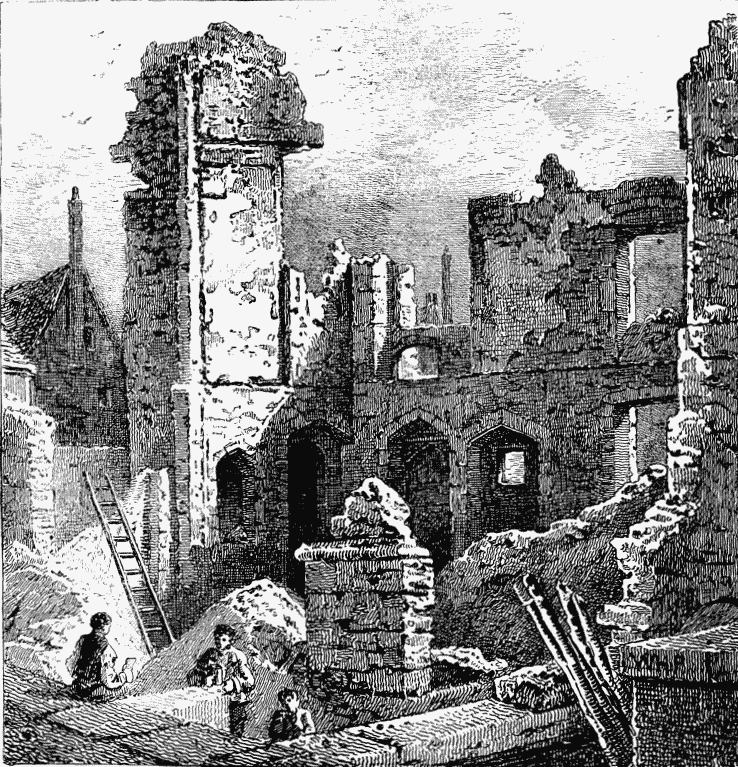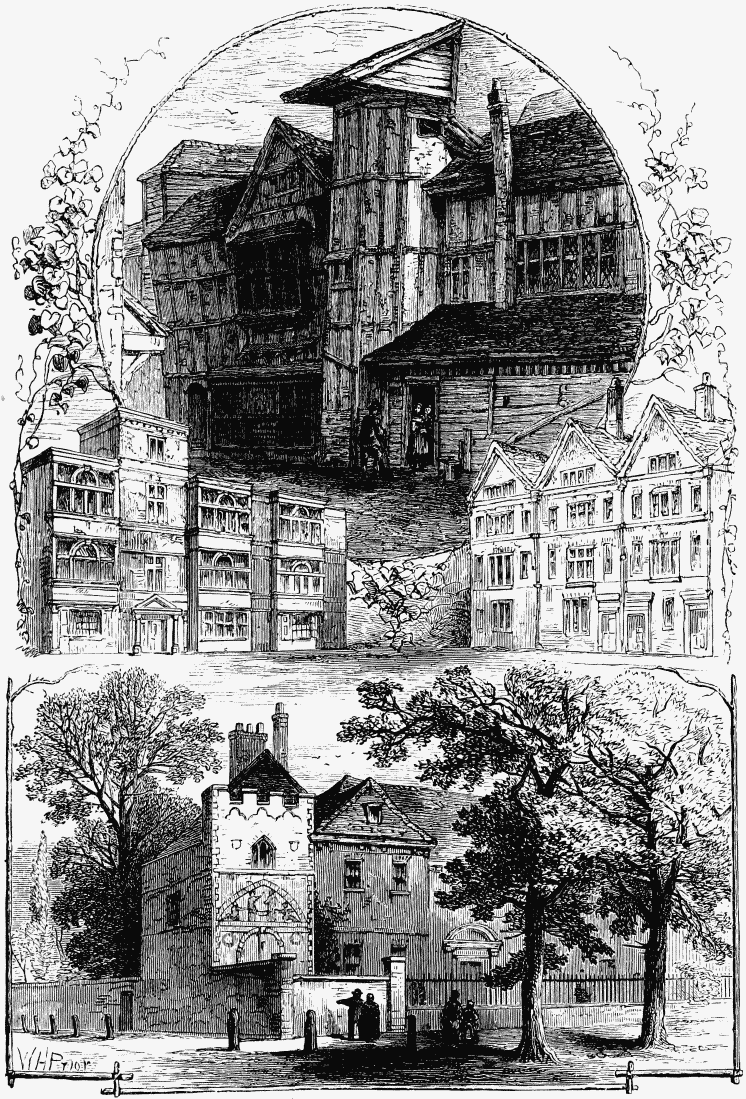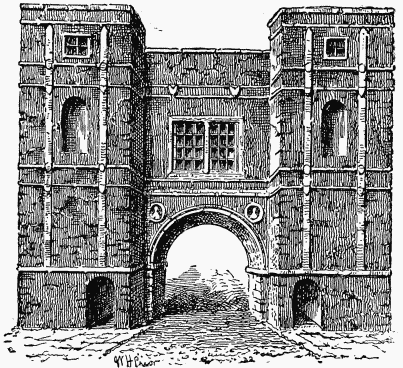Old and New London: Volume 2. Originally published by Cassell, Petter & Galpin, London, 1878.
This free content was digitised by double rekeying. All rights reserved.
'Aldgate, the Minories and Crutched Friars', in Old and New London: Volume 2, (London, 1878) pp. 245-250. British History Online https://www.british-history.ac.uk/old-new-london/vol2/pp245-250 [accessed 11 April 2024]
In this section
CHAPTER XXX.
ALDGATE, THE MINORIES, AND CRUTCHED FRIARS.
The Aldgate of 1606—Brave Doings at Aldgate—The Conduit—Duke's Place—The Priory of the Holy Trinity—The Jews in Aldgate—The Abbey of St. Clare—Goodman's Fields—The Minories—A fine old London House—Crutched Friars—Sir John Milborne—The Drapers' Almshouses.
"The gate described by Stow," says Cunningham, "was taken down in 1606, and a new one erected in its stead, the ornaments of which are dwelt on at great length by Stow's continuators. Two Roman soldiers stood on the outer battlements with stone balls in their hands, ready to defend the gate; beneath, in a square, was a statue of James I., and at his feet the royal supporters. On the City side stood a large figure of Fortune, and somewhat lower, so as to grace each side of the gate, gilded figures of Peace and Charity, copied from the reverses of two Roman coins, discovered whilst digging the new foundations for the gate. The whole structure was two years in erecting."
Ben Jonson, in his Silent Woman, says, "Many things that seem foul in the doing, do please done. You see gilders will not work but inclosed. How long did the canvas hang before Aldgate? Were the people suffered to see the City's Love and Charity while they were rude stone, before they were painted and burnished?"

RUINS OF THE CONVENT OF ST. CLARE. (Form a View published by J. T.Smith, 1797).
The City's Love and Charity were standing in 1761; the other statues had been long removed.
Through this gate—under which, about the year 1607, were discovered coins of Trajan, Domitian, and Valentinian—the Barons, in 1215, entered London by consent of the citizens, on their way to meet King John. This was one of the most ruinous of the City gates, and the Earl of Essex and Earl of Gloucester repaired it with the stones from monasteries and Jews' houses, that had been ruthlessly pulled down on purpose.
During the reign of Edward IV., Aldgate again felt maces beat at its doors, and clothyard shafts tremble in its tough planks. In 1471 the Bastard Falconbridge, collecting seamen in Essex and Kent, came with his vessels and anchored near the Tower. On hearing of his intention, the mayor and alder men fortified the Thames shore, from Baynard Castle to the Tower, and stood to their guns. The Bastard, finding the south side unapproachable, then assailed the east of London, and attacked Aldgate with 5,000 turbulent men; but the citizens, letting the portcullis drop, entrapped and cut off many of their assailants. Elated by this, Robert Bassett, the alderman of Aldgate, ordered the portcullis to be drawn up, in God's name, and, by a brave sortie, drove the enemy back as far as St. Botolph's. At this juncture, Earl Rivers and the Constable of the Tower arriving with reinforcements, drove the rebels back as far as Mile End, Poplar, and Stratford. Many of the assailants of Aldgate were slain in this attack, after which the Bastard fled.

WHITTINGTON'S HOUSE, GRUB STREET. (Smith, 1811.)
GENERAL MONK'S HOUSE.
BLOOMFIELD'S HOUSE (1823).
REMAINS OF ALDGATE, BETHNAL GREEN. (Malcolm, 1800.)
Near this gate, in the reign of Edward I., in a small projecting turret, was a hermitage. Without Aldgate was a conduit, erected in 1535. The water was conveyed from Hackney. The crowd of poor water-bearers, with their tubs, pails, and tankards, proving, however, a nuisance, the conduit was removed into a side court.
Among the records of the City of London is a lease granting the whole of the house above the gate of Aldgate to the poet Chaucer, in 1374.
In Aldgate all the prisoners of the Poultry Computer were lodged after the Great Fire, till the prison could be rebuilt. In the year 1760, when the City gates were taken down to widen the streets, Aldgate was bought by Mr. Mussell, of Bethnal Green, a zealous antiquary, who inhabited a house belonging to Lord Viscount Wentworth, built in the reign of James II. Mr. Mussell rebuilt the gate on the north side of his mansion, to which he henceforth gave the name of Aldgate House. There was a bas-relief on the south front, carved from Wat Tyler's tree, an old oak which once grew on Bow Common, and which the aldermen and council had had carved to adorn the old City gate, A year ago, as workmen were excavating near Aldgate Pump, some very curious arches, resembling the cloisters of an ancient abbey, were discovered.
Duke's Place, Aldgate, was so called from Thomas Howard, Duke of Norfolk, who was beheaded in 1572 for his political intrigues with Mary Queen of Scots, to whose hand the weak and ambitious Catholic nobleman had aspired. "I find," says Strype, "the said duke, anno 1562, with his Duchess, riding thither through Bishopsgate Street to Leadenhall, and so to Cree Church, to his own place, attended with a hundred horse in his livery, with his gentlemen afore, their coats guarded with velvet, and four heralds riding before him, viz., Clarencieux, Somerset, Red Cross, and Blue Mantle." The precinct of the Priory of the Ho Trinity, without Aldgate, was given by Henry VII to Sir Thomas Audley, afterwards Lord Chancello who lived there, and died there in 1554. St. Thomas, wishing to rebuild St. Catherine Cre offered the parish the priory church and its nin bells in exchange for their own. The parish refusin to purchase, Sir Thomas offered the church an steeple to any one who would cart it off, but in vair He then pulled it down anyhow, breaking half the stones, and sold the bells to Stepney parish an St. Stephen, Coleman Street. The Duke of Not folk, marrying Sir Thomas's daughter, inherited th estate. The Earl of Suffolk, son of the duke wh was beheaded, sold the priory precinct and th mansion-house of his mother to the City. I the year 1622 the inhabitants of Duke's Place having a quarrel with the parishioners of St. Catherine, obtained leave from King Charles to rebuild the priory church, aided by the donation of Lord Mayor Barkham. The people of Duke's Place claim the priory church as the place of inter ment of Fitz Alwyn (draper), the first Lord Mayo of London, but their claim is highly doubtful. It 1650, when they were allowed by Cromwell, in his tolerant wisdom, to return to England, many Jews settled in Duke's Place, where, after the Restora tion, they still more flourished. The German and Polish Jews built a synagogue here, in 1692, which was rebuilt in 1790. Over the porch of this building is a large hall, once used for the celebration of the weddings of poor Jews. A writer in the Jewish Chronicle says:—
"The influx of Jews from Lithuania and Germany became greater and greater towards the end of the seventeenth century. The aristocratic Sephardim, whose ancestors had banqueted with sovereigns, and held the purse-strings of kings, looked, it must be owned, with some disdain on their poorer and humbler brethren—the plebeian Ashkenazim, who had dealt in worn garments or huckstered in petty commodities on the banks of the Vistula, or in German Ghettos. The Portuguese did not allow the Germans to have any share in the management of congregational affairs. The Germans, in point of fact, were treated as belonging to a lower caste, and the only functions that a member of that nationality was permitted to fulfil were the useful, albeit lowly duties of beadle, which were actually entrusted to a German—a certain Benjamin Levy. In time the Germans resolved to establish a synagogue of their own, and in 1692, during the reign of William III., one of their body, a philanthropic and affluent individual, named Moses Hart, built a place of worship in Broad Court Duke's Place."
In the Minories, lying between Aldgate and Tower Hill, there stood, in the Middle Ages, an abbey of nuns of the order of St. Clare, called the Minories, founded in 1293 by Edmund, Earl of Lancaster, Leicester, and Derby, and brother to Edward I., to receive nuns who were brought from Spain by his wife Blanche, Queen of Navarre. Ribideneira, the Spanish Jesuit, who wrote the "Lives of the Saints," tells us that St. Clare was an Italian saint who, by the advice of St. Francis, ran away from her father's house to take refuge in a convent, where she miraculously multiplied the bread, and rebuked the devil in person. She died in 1253 (Henry III.) During the plague of 1515 twenty-seven of these nuns were carried off, besides lay servants. The nunnery, which spent £418 8s. 5d. a year, was surrendered by Dame Elizabeth Salvage, the last abbess, to Henry VIII., in 1539. After the dissolution the nunnery became the residence of many great people; first of all, of John Clark, Bishop of Bath and Wells, Henry's ambassador, afterwards of officers of the Tower; and early in 1552 Edward VI. gave it to Henry, Duke of Suffolk, father of Lady Jane Grey. In Stow's time, in place of the nunnery were built "divers fair and large storehouses for armour and habiliments of war, with divers workhouses serving the same purpose."

ALDGATE.
The Church of the Priory of the Holy Trinity, in the Minories, was founded by Matilda, queen of Henry I., in 1108. It escaped the Great Fire, but becoming dangerous was taken down and rebuilt in 1706. In Strype's time this church claimed mischievous privileges, such as marrying without a licence. In the church is the tomb of William Legge, that faithful servant of Charles I., to whom the king confided his message to his degenerate son, enjoining him to remember "the faithfullest servant ever prince had." Here, too, was buried Legge's son, the first Earl of Dartmouth, to whose father Charles II. had granted the Minory House.
"Near adjoining to this abbey, called the Minories," says Stow, more autobiographically than usual, "on the south side thereof, was some time a farm belonging to the said nunnery; at the which farm I myself (in my youth) have fetched many a halfpenny worth of milk, and never had less than three ale-pints for a halfpenny in the summer, nor less than one ale-quart for a halfpenny in the winter, always hot from the cow, as the same was milked and strained. One Trolop, and afterwards Goodman, were the farmers there, and had thirty or forty kine to the pail. Goodman's son being heir thereof, let out the ground, first for grazing of horses, and then for garden plots, and lived like a gentleman thereby. He lieth buried in St. Botolph's Church."
In Strype's time Goodman's Fields were "nolonger fields and gardens, but buildings consisting of many fair streets, as Maunsel Street, Pescod or Prescot Street, Leman Street, &c., and tenters for clothworkers, and a large passage for carts and horses out of Whitechapel into Wellclose, besides many other lanes." "On the other side of that street," says Stow, "lieth the ditch without the walls of the City, which of old times was used to lie open, and was always (from time to time) cleansed from filth and mud, as need required; and was of great breadth, and so deep, that drivers watering horses, where they thought it shallowest, were drowned, both horse and man. But now of later time the same ditch is enclosed, and the banks thereof let out for garden plots, and divers houses be thereon builded; whereby the City wall is hidden, the ditch filled up, a small channel left, and made shallow enough."
That miserable and worthless coward, Lord Cobham, who falsely accused Raleigh of a share in his plot, almost died of starvation in the Minories, in the mean lodgings of a poor woman who had been his laundress. Congreve has some verses full of strained wit and gallantry, after his manner, on the Mulcibers of the Minories, who deform themselves in shaping the stays of steel that "give Aurelia's form the power to kill." During the Spa Fields riots of December 2, 1816, when young Watson led on the mob, and Thistlewood tried to persuade the soldiers to surrender the Tower, two gun-shops in the Minories were broken open by the rioters, and many guns and one small brass field-piece stolen. When the cavalry arrived, however, the field-piece was soon deserted.
One of the most extraordinary old houses in London was one sketched by J. T. Smith, in 1792, and taken down in 1801. It stood at the end of a low dark court on the south side of Hart Street, and was universally known in Crutched Friars as Whittington's Palace. The last lodger was a carpenter, who had sunk a saw-pit at the north end of the courtyard. The whole front of the house, which had originally formed three sides of a square, was of carved oak. The tradition was that the cats' heads carved on the ceilings always had their eyes directed on the spectator wherever he stood, and that even the knockers had once been shaped like cats' heads. Two sides of the outer square were nearly all glass lattice, and above and below ran wild-beasts' heads and crouched goblins, that acted as corbels. The doorway panels were richly carved, and above and below each tier of windows were strings of carved shields, including several arms of the City companies. A curious old house which formerly stood in the Minories is shown on page 252. It was at one time an inn, and when taken down in 1793 the timber-work was so firmly fixed together, that it had to be pulled asunder by horses.
In 1842 a curious group of three seated figures of goddesses, bearing baskets of fruit in their laps, were discovered in digging a sewer in Hart Street, Crutched Friars. The group is now at the Guildhall.
The House of Crutched Friars, or Friars of the Holy Cross, at the corner of Hart Street, was founded by Ralph Hosiar and William Sabernes, about the year 1298. The founders themselves became friars of the order, and to them Stephen, the tenth prior of the Holy Trinity, granted three tenements for 13s. 8d. In the reign of Henry VIII. the Crutched Friars solicited the City magistrates to take the establishment under their patronage. At the dissolution the watchful emissaries of Cromwell caught the Prior of Crutched Friars flagrante delicto, and down at once went the king's hammer upon the corrupt little brotherhood. The church was turned into a carpenter's yard and a tennis-court, and the friars' hall eventually became a glass-house. On the 4th of September, 1575, Stow says, a terrible fire burst out there that destroyed all but the stone walls." Turner dedicated his folio "Herbal" (1568) to Queen Elizabeth from this place.
The great benefactor to the Crutched Friars was Sir John Milborne, who was buried in their church. This worthy draper, mayor in the year 1521, was the founder of certain Drapers' Almshouses in the parish of St. Olave's, close to the old priory. The will, given by Strype, is a curious exemplification of the funeral customs of the old religion, and of the superstitions of the reign of Henry VIII. By the last testament of Sir John, his thirteen bedesmen from the adjoining almshouses were required to come daily to the church and hear mass said or sung near the tomb of their benefactor, at eight a.m., at Our Lady's altar in the middle aisle; and before the said mass the thirteen bedesmen, one of them standing right over against the other and encompassing the tomb, were severally, two and two of them together, to say the "De Profundis," and a paternoster, ave, and creed, with the collect thereunto belonging; and those who could not say the "De Profundis" were required to say a paternoster, ave, and creed for the souls of Sir John and Dame Johan, and Margaret, Sir John's first wife, and the souls of their fathers, mothers, children, and friends, and for "all Christian souls." A good and comprehensive benediction, it cannot be denied.
The inmates of the Drapers' Almshouses received 2s. 4d. a month, the first day of every month, for ever. The bedesmen were to be of honest conversation, and not detected in any open crime. They were forbidden to sell ale, beer, or wine, "or any other thing concerning tippling." Over the gate of Milborne's Almshouses, says Strype, there was "a four-square stone, with the figure of the Assumption of our Blessed Lady, supported by six angels in a cloud of glory." Sir Richard Champion, mayor and draper, in Elizabeth's reign, gave £19 14s. a year to these same bedesmen. He also desired that every Sunday thirteen penny loaves of white bread should be given to thirteen poor people at the churches of St. Edmund, Lombard Street, and St. Michael's, Cornhill. He also gave the poor of each parish one load of charcoal (thirty sacks) every year; and to carry out these bequests, he left the Drapers' Company twenty-three messuages and eighteen garden-plots in the parish of St. Olave's, Hart Street. But Anthony Munday denies these last bequests, and thinks that Stow unintentionally slandered the Drapers' Company, by asserting that the terms of the will had not been carried out. Lord Lumley's house, built by Sir Thomas Wyat, in the reign of Henry VIII., adjoined these almshouses, and not far off was the house of the prior of Horn Church, in Essex, Northumberland House; and Poor Jewry, a small district of Jews.
